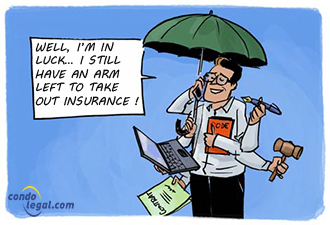Date published: 17/02/2024
10 tips to avoid water damage claims
 While policyholders often fear fire and theft, it's actually water that takes center stage in terms of the number of claims and damages to co-ownerships. While water is a source of life, it also supports the growth of spores, fungi, and mold. Unfortunately, these fungi, delightful in a sauce, are not edible when growing on walls and are even harmful to the health of occupants, and what's more, they are excluded from insurance policies. This exclusion poses a financial challenge for co-ownership associations, lacking insurance support for repairs.
While policyholders often fear fire and theft, it's actually water that takes center stage in terms of the number of claims and damages to co-ownerships. While water is a source of life, it also supports the growth of spores, fungi, and mold. Unfortunately, these fungi, delightful in a sauce, are not edible when growing on walls and are even harmful to the health of occupants, and what's more, they are excluded from insurance policies. This exclusion poses a financial challenge for co-ownership associations, lacking insurance support for repairs.
Essentially, for water damage to be covered, it must be sudden and accidental. Since fungi and mold develop gradually, such claims are not admissible. However, sudden and accidental damages can still be anticipated and thus prevented before they occur. Here are 10 tips and sources of water damage where action can be taken to prevent either a sudden and accidental damage or an uncovered damage.
- When doing carpentry work, always ensure you know where the water pipes are located. Moulding at the bottom of walls is often nailed into a water pipe, holding until the old moulding is removed...
- Never renovate when stores are closed. You might regret it, for example, when a valve breaks off in your hand, when you're missing a piece after changing a toilet, or when a simply unscrewed faucet starts leaking.
- Know the location of water shut-off valves for each water outlet and the main valve. Many co-ownerships also have valves for each floor: knowing their locations is crucial. It's common for a bathroom unit's valve to break when operated, which is why knowing the main valve is more than important.
- Most refrigerators now provide fresh water and ice, coming with a water hose (often cheap) that runs through several cabinets. Ensure this hose is of good quality, protected (like the hose that runs at the bottom of a knife cabinet), and installed by an expert... please don't improvise as an expert even if you're very good at everything you do.
- Plumbing wears out prematurely, be aware. Have a replacement plan for speedways (hoses that come out of the wall and connect to your water-using appliances). Before starting the replacement, don't forget the points above!
- Air conditioning units condense and produce water. Very, too, so often, the water discharge from units is poorly managed and damages the building. As it's usually gradual damage, it harms the building over a long period and is not insured since it's not sudden and accidental.
- Irrigation and outdoor sprinkler systems: in large co-ownerships, there's often a terrace beautified by plant arrangements that require an irrigation and sprinkler system. Winter is harsh on these systems, and they are often poorly winterized, leading to damages during cold winters.
- Household drains and columns: rags, hair, cooking grease, hygiene products, everything is good for clogging domestic drains. Maintenance is necessary. The good news? It's not up to you, just make sure the association is timely in its maintenance.
- Roofing: Whether you live in the basement or the top floor, the roof belongs to the co-ownership, and necessary maintenance must be planned. Summers are getting hotter, rains more intense, and droughts longer. The roof can deteriorate faster than expected. Sun-exposed facades wear out more, and caulking often needs redoing. Even a recent roof will need an annual inspection in summer. As for the winters we know, roof drains and various openings need to be checked before or after significant rain-snow precipitation, etc.
- Require co-owners to have their washing machines and dishwashers connected by experts, and you will surely save problems. The "handy person who has seen someone do it in the past or has done it themselves and it had gone well" is not among the experts.
In conclusion, managing water-related risks in co-ownerships requires constant vigilance and a proactive approach. Understanding that water damage can be both sudden and gradual highlights the importance of investing in prevention and regular maintenance. By adopting responsible practices and following sound advice, co-ownership associations can not only avoid high repair costs but also ensure a safer and healthier living environment for all residents.
 WHAT YOU SHOULD KNOW ! This list wouldn't be complete without mentioning the increasingly important role of technology in prevention: water detectors and smart valves. They are fantastic prevention tools. Their technology is becoming more refined, making them a significant prevention tool. Prevcan is an organization that can guarantee quality products.
WHAT YOU SHOULD KNOW ! This list wouldn't be complete without mentioning the increasingly important role of technology in prevention: water detectors and smart valves. They are fantastic prevention tools. Their technology is becoming more refined, making them a significant prevention tool. Prevcan is an organization that can guarantee quality products.
 WHAT TO KEEP IN MIND: InInvesting in prevention may seem unattractive at first, but it often turns out to be more economical than one might think!
WHAT TO KEEP IN MIND: InInvesting in prevention may seem unattractive at first, but it often turns out to be more economical than one might think!
 WARNING! Never underestimate the importance of prevention and regular maintenance to avoid gradual damages not covered by insurance, especially those related to water, which can have costly and harmful long-term consequences.
WARNING! Never underestimate the importance of prevention and regular maintenance to avoid gradual damages not covered by insurance, especially those related to water, which can have costly and harmful long-term consequences.
Charles-Antoine Carra CPA, CMA
Damage insurance broker
Fort assurances
514 374 9944 x 259
3737 Crémazie Est, bureau 1001, Montréal QC H1Z 2K4
[email protected]
Back to chronicles